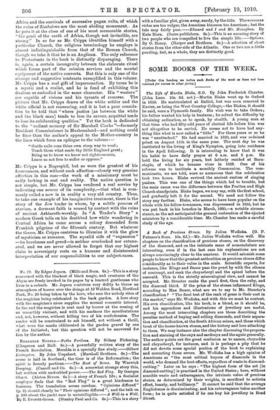A Book of Precious Stones. By Julius Wodiska. (G. P.
Putnam's Sons. 10s. 6d.)—Mr. Julius Wodiska writes well. His chapters on the classification of precious atones, on the discovery of the diamond, and on the intricate maze of nomenclature are interesting, even if in the last case his explanations are not always convincingly clear to the amateur. It would astonish some people to know that the greatest authorities on precious stones differ considerably as to their value in the scale. Scientific experts, for instance, like Kluge and Bauer pass the pearl by with the silence of contempt, and rank the chrysoberyl and the spinel before the emerald. This is the strictly mineralogical view, and cannot be accepted. Mr. Streeter ranks the pearl first, then the ruby, and the diamond third. If the price of the atones influenced Kluge, according to Max Bauer, what are we to say to Mr. Streeter's classification ? " The final test of the rank of gems is their cost in the market," says Mr. Wodiska, and with this we must be content. His own classification, like his book, is a blend, as it should be, and his appendices and illustrations of jewellery are usefuL Among the most interesting chapters are those describing the peculiar method of buying and selling diamonds, and their separa- tion and classification, at the South African mines, and those which treat of the lesser-known stones, and the history and lore attaching to them. We may instance also the chapter discussing the prepara- tion and staining of the onyx and sardonyx and the agate generally. The author points out the great confusion as to names, chrysolite and chrysoberyl, for instance, and it is perhaps a pity that he did not devote some special portion of the book to explaining and correcting these errors. Mr. Wodiska has a high opinion of Americana as "the most critical buyers of diamonds in the world, who demand the best effects, regardless of waste in diamond- cutting." Later on he says : "The highest form of the art [in diamond-cutting] is practised in the United States ; here, without sensible waste and extravagance, the intrinsic value of precious stones, as determined by their weights, is sacrificed to artistic effect, beauty, and brilliancy." It cannot be said that the average Englishman is discriminating, and his extravagance takes another form ; he is quite satisfied if he can buy his jewellery in Bond Street.








































 Previous page
Previous page